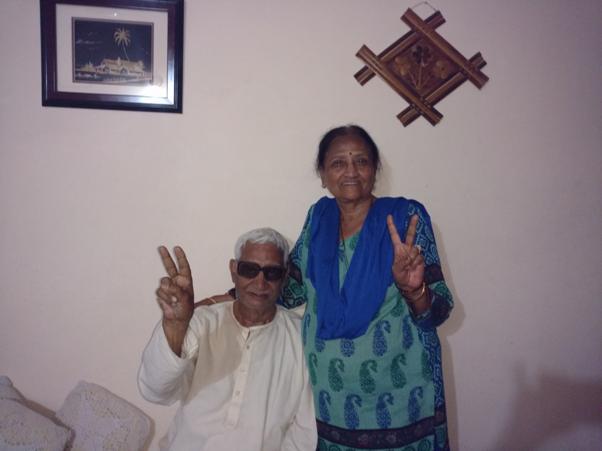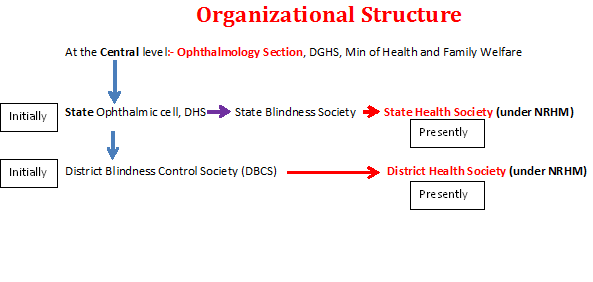
Lecture available here: http://www.ihatepsm.com/resource/national-program-control-blindness-npcb
• launched in the year 1976 as a 100% Centrally Sponsored scheme
• Goal: reduce the prevalence:
– From 1.4% ->0.3%
– (As per 2006-7 survey, the prevalence was 1.0%)
• Various activities/initiatives undertaken during the Five Year Plans under NPCB are targeted towards achieving the goal of reducing the prevalence of blindness to 0.3% by the year 2020.
OBJECTIVES
• To reduce the backlog of avoidable blindness
– through identification and treatment of the curable blind at all the three (primary, secondary and tertiary) levels
• To develop Comprehensive Eye Care facilities in every district as the strategy for controlling blindness and not just curative, i.e. “Eye Health for All”
• Upgradation of Regional Institutes of Ophthalmology (RIO’s) to become centers of excellence in the sub-specialties of ophthalmology
• To improve quality of service delivery by strengthening the existing infrastructure facilities and additional human resources for these
• To enhance community awareness on eye care especially PREVENTIVE measures
• Encourage research for prevention of blindness and visual impairment
• To secure participation of Voluntary Organizations/Private Practitioners in eye Care.
Suggested Mnemonic: BCRQARP
Strategies
• To reduce the backlog of avoidable blindness
– through identification and treatment of the curable blind at all the three (primary, secondary and tertiary) levels
• To develop Comprehensive Eye Care facilities in every district as the strategy for controlling blindness and not just curative, i.e. “Eye Health for All”
• Upgradation of Regional Institutes of Ophthalmology (RIO’s) to become centers of excellence in the sub-specialties of ophthalmology
• To improve quality of service delivery by strengthening the existing infrastructure facilities and additional human resources for these
• To enhance community awareness on eye care especially PREVENTIVE measures
• Encourage research for prevention of blindness and visual impairment
• To secure participation of Voluntary Organizations/Private Practitioners in eye Care.
• Active screening of population above 50 years of age for cataract (reducing backlog)
• Screening of children for refractive errors and provision of free glasses to the needy
• Coverage of the underserved areas with eye care
• Capacity building by improving the quality of skill of eye care providers
• IEC activities for creating awareness on eye care in the community
• RIO’s, ophthalmology institutes and medical colleges to be improved and strengthened
• District hospitals also to be strengthened by upgrading infrastructure and contractual staff and funds
• Emphasis on PRIMARY eye care and establish vision centers on all PHC’s
• Creating Multipurpose District Mobile Ophthalmic Units for improving coverage
Suggested Mnemonic: FCSSUQIRDPM
Organizational Structure
District Health Society (blindness section) is responsible for:
• Delivery of services to the grassroots level and
• Collection of data from villages and taluks and conveying the same to the State and finally to the Centre
Services are delivered at Primary, secondary and tertiary level by the following:
Primary level
• Sub-district hospitals
• CHC
• Upgraded PHC
• Mobile units
Secondary level
• District hospital
• NGO hospital
Tertiary level
• Regional Institutes of Ophthalmology
• Centre of excellence in medical colleges
Blindness Division (under NPCB) of State Health Society
• Primary purpose is to plan, implement and monitor blindness control activities:
in all the districts of the State
as per the directions of the Centre government (NPCB- Ophthalmology Section)
• These include:
To coordinate and monitor with all the District Health Society (blindness division)
To procure funds, equipment and drugs for eye care and monitor their use
To involve NGO’s and Private Practitioners providing free/Subsidized eye care
To promote eye donation and
monitor the collection and utilization of eyes collected by eye donation centres
Blindness related functions of District Health Society
The primary purpose of the District Health Society is to plan, implement and monitor blindness control activities in the district
• To assess the magnitude of blindness in the district
• To organize screening camps for identifying those requiring cataract surgery and other blinding disorders and then
– organize transportation and
– conduct of free medical or surgical treatment
– To train community level workers
• To involve voluntary and private hospitals providing eye care services in the District
• To organize screening of school children for detection of refractive errors and other eye problems and
– provide free glasses to poor children;
– To promote eye donation and monitor the utilization of the donated eyes
School Eye Screening Program
• Recommended procedure is:
– Trained teachers screen the students
– Children suspected to have refractive error are seen by ophthalmic assistants
– Corrective spectacles are prescribed
– For persons below poverty line, these are given free
Collection and Utilization of Donated Eyes
• Eye donation fortnight is organized from 25th August to 8th September every year
• Voluntary organizations such as
– Lions International,
– Rotary International and
– their branches,
– organize eye camps in remote rural and urban areas as per the government guidelines
WHO Assistance for Prevention of Blindness
• Intra – country fellowships in
– corneal transplantation
– Vitreo-retinal surgery
– Lasers in ophthalmology and
– Pediatric ophthalmology
• Pilot survey on childhood blindness in Delhi
• Training in district programme management
• Study on situational analysis of eye care infrastructure and human resources in India
• High quality workshops in eye care for faculty of medical colleges
• Development of POA for ‘Vision 2020: The Right to Sight’ initiative
Vision 2020: The Right to Sight
Global initiative by WHO to reduce avoidable blindness by 2020
• Target diseases
Cataract
Refractive errors
Glaucoma
Diabetic retinopathy
Universal Eye Health A Global Action Plan 2014 – 2019
• The vision of this action plan is a world in which
– nobody is needlessly visually impaired,
– where those with unavoidable vision loss can achieve their full potential, and
– where there is universal access to comprehensive eye care services
• WHO estimates that if only TWO major causes can be controlled, 2/3 of visually impaired can regain good sight.
• These two measures are:
– Providing refractive services
– Cataract surgery
• Reduction of ‘avoidable blindness’ depends not ONLY on specific eye care services but also on other sectors like:
– RCH: immunization (rubella, measles), nutrition, prematurity,
– Safe water and basic sanitation
– Also, eye health is influenced by control of:
– Non-communicable disease e.g. DM, HT etc.
– Communicable diseases e.g. trachoma
– Geriatric health care programs (80% of avoidable blindness in this age group) etc.
• Hence eye health services can be strengthened by integrating into primary health care
• WHO has suggested 3 indicators for helping the countries to assess if the universal eye health is adequate or not:
1. Prevalence and causes of visual impairment
i. Target has been set as ‘Reduction (of avoidable blindness) by 25% by 2019 (from the 2010 levels)’
ii. Hence the target will be different for each country depending upon the prevalence in 2010
2. The number of eye care personnel
3. Cataract surgical service delivery:
• No. of surgeries performed per million population in an year = “Cataract Surgical Rate”
• No. of individuals with bilateral cataract induced impairment, who have deceived cataract surgery on at least one eye = “Cataract Surgical coverage”
For lecture click here: http://www.ihatepsm.com/resource/national-program-control-blindness-npcb
